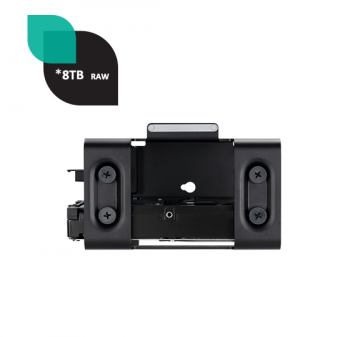Uh, the website shows two slots located towards the front of the chassis, ...
Are they industry-standard M.2 SSDs? Probably not. But if it works like a disk and quacks like a disk, it's probably a disk.
If looks like an iMac Pro NAND daughter card and quacks like an iMac Pro daughter card ( also hooked to the T2 chip with the SSD controller 'brains' in it.) , it is probably a NAND daughter card.
If you look carefully at the page you did a screen shot of, Apple specifically calls these 'modules' not 'drives' , 'storage', or 'SSDs'.
iMac Pro 2017 teardown step 8 [ OK not exact twins. The picture on Mac Pro page looks like these have slicker 'black' heat sinks , but essentially the same thing. More pictures on teardown site.] .
https://www.ifixit.com/Teardown/iMac+Pro+Teardown/101807
There is another picture with the heat sinks off and there isn't a chip large enough to be a top end SSD controller on the card. So it is a 'brainless' card. There is a chip that is probably a buffer communications chip between the modified PCI-e standard connection and the NAND chips. The T2 is more than an inch or so away so the T2 signal probably needs a slight tweak and some of the NAND overhead handled.
The T2 has a SSD controller logic inside of it. All it needs is NAND chips to 'talk' to complete the implementation of a full SSD. Apple probably has lifted the exact same design as the iMac Pro. Same upper cap of 4TB. The daughter cards don't have an SSD controller chip on them so they are not an SSD.
Third party solutions are not likely because SSD controllers are typically quite picky which NAND chips they are coupled do for a specific SSD controller firmware they are coupled to. There aren't many 3rd party solutions for sticking different NAND chipset inside of a Samsung SSD. Pragmatically same issue here.
The two cards allows Apple to get to 8 NAND chips and to 4TB capacity target without bleeding edge NAND chips ( that didn't particularly exist in 2017 anyway).
If there is a NAND failure then you won't need a whole new motherboard ( like most other Apple T2 implementations.). Also can decommission these discrete NAND systems at end of life (or end of life with some company) by just destroying the storage chips and not the whole logic board.
The quirky Mac Pro part is that the iMac Pro minimally comes with two 512GB NAND cards. The Mac Pro tosses in a "discount" 256GB card (and doesn't offer a 512GB pairing of that card). It would not be too surprising if next iMac Pro comes with a 512GB entry disk option if Apple gets large enough takers on this entry Mac Pro configuration.
The regular iMac may also eventually get this set up. Where not pressed for most minimal logic board space due to the enclosing container this has substantive upsides to soldering the whole SSD down while still effectively the same security profile bound to the specific T2 chip of the system.
P.S.
"... Uh, the website shows two slots located towards the front of the chassis, next to the intake fans, and mentions that these are SSDs in at least two places. ..."
The these NAND modules are not behind or 'next to' the fans. They are on the other side of the logic board from the fans (there is whole logic board between these and the fans) . These NAND modules are actually in front of the blower on the "back"/"bottom" side of the logic board with the RAM ( and reverse side under CPU). The blower actually pulls air through the system and blows out the back. There is an animation here
https://www.apple.com/mac-pro/design/ about "fan side" and "blower side".
Splitting up the up to eight NAND chips incrementally helps with cooling too.




